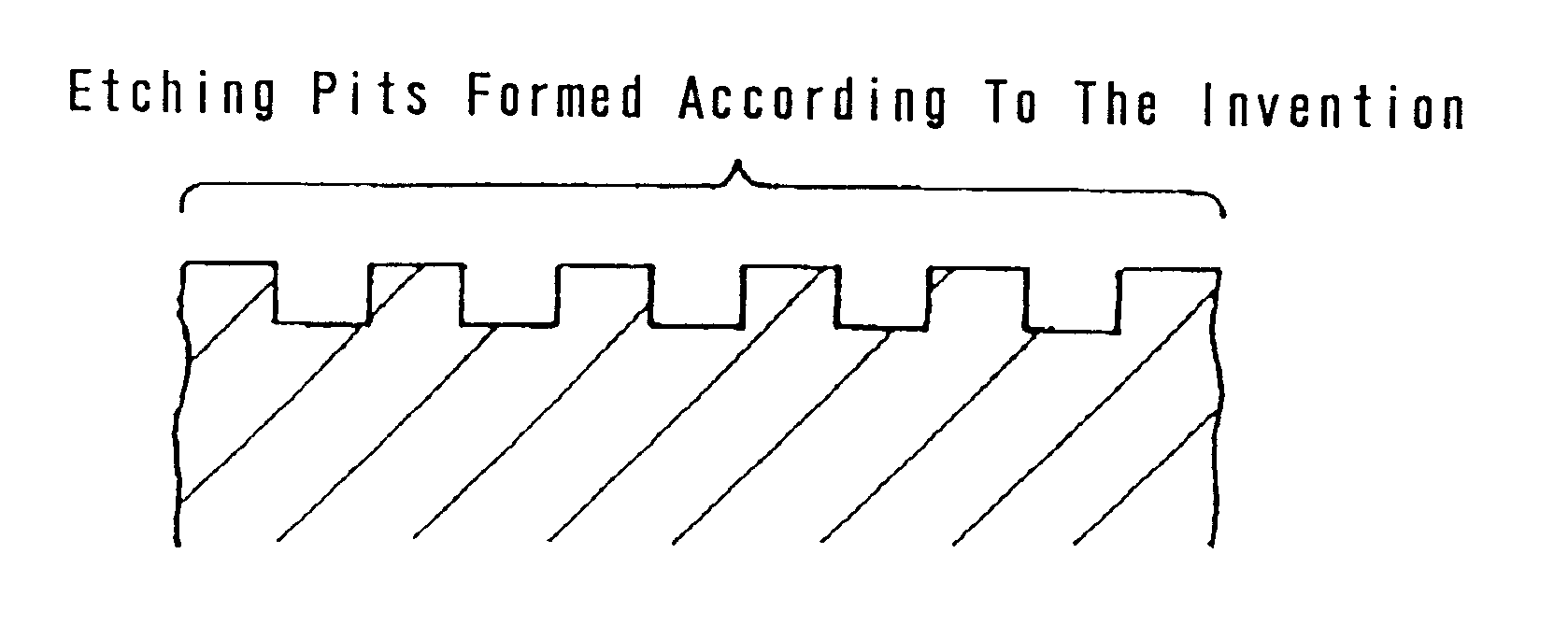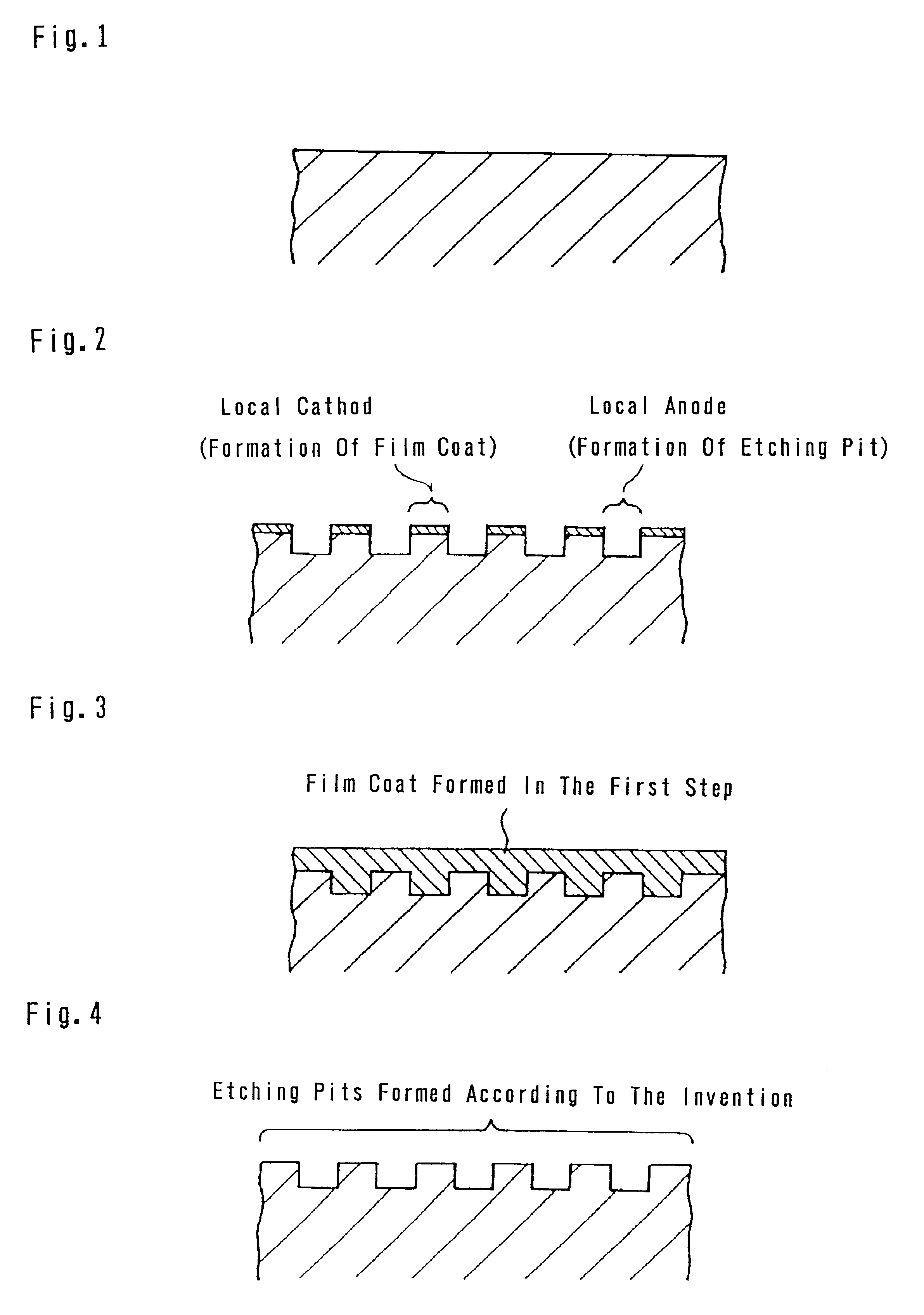Surface treatment process of metallic material and metallic material obtained thereby
a surface treatment and metallic material technology, applied in the direction of metallic material coating process, solid-state diffusion coating, coating, etc., can solve the problems of sharp and deep etching pits on the surface of metal materials, and achieve satisfactory adhesiveness and excellent adhesiveness
- Summary
- Abstract
- Description
- Claims
- Application Information
AI Technical Summary
Benefits of technology
Problems solved by technology
Method used
Image
Examples
embodiment example 1
A specimen of a cold rolled steel plate (70.times.150.times.0.8 mm) having a surface cleansed by means of an alkaline degreasing agent was immersed into a manganese phosphate treatment solution heated to 90.degree. C. for 10 minutes to form a manganese phosphate film coat at a rate of 14 g / m.sup.2 on the surface. The manganese phosphate used in the above process had been prepared by adding manganese carbonate to an aqueous solution containing phosphoric acid by 30 g / l and nitric acid by 5 g / l so as to make it show a manganese ion concentration of 10 g / l.
The cold rolled steel plate specimen now carrying a manganese phosphate film coat was then immersed for 2 minutes in 10% hydrochloric acid solution at room temperature to remove the manganese phosphate film coat and washed with water immediately thereafter. The obtained cold rolled steel plate specimen was measured for surface coarseness to see values of Ra=0.4.mu.m and Rz=2.6 .mu.m.
After that the solution A and the solution B of a d...
embodiment example 2
A specimen of a hot rolled steel plate (25.4.times.60.3.times.2.54 mm) having a surface cleansed by means of an alkaline 25 degreasing agent and having subsequently oxide scales removed therefrom by immersing it in 10% hydrochloric acid for 30 minutes at room temperature was immersed into a zinc calcium phosphate treatment solution heated to 90.degree. C. for 10 minutes to form a zinc calcium phosphate film coat at a rate of 12 g / m.sup.2 on the surface. The zinc calcium phosphate solution used in the above process had been prepared by adding zinc white and calcium hydroxide to an aqueous solution containing phosphoric acid by 15 g / l and nitric acid by 10 g / l so as to make it show a zinc ion concentration of 5 g / l and a calcium ion concentration of 3 g / l.
The hot rolled steel plate specimen now carrying a zinc calcium phosphate film coat was then immersed in an 10% hydrochloric acid solution at room temperature for 3 minutes to remove the manganese phosphate film coat and washed with ...
embodiment example 3
A specimen of a stainless steel plate ( JIS SUS304, 50.times.150.times.0.3 mm) with a profile as shown in FIG. 6 having a surface cleaned by means of an alkaline degreasing agent was immersed into a 10% hydrochloric acid solution at room temperature for 10 minutes for acid pickling. Then, the stainless steel plate was immersed into an iron oxalate treatment solution heated to 95.degree. C. for 10 minutes to form an iron oxalate film coat at a rate of 6.5 g / m.sup.2 on the surface.
The iron oxalate treatment solution used in the above process had been prepared by adding 30 g / l oxalic acid to an aqueous solution containing nitric acid by 5 g / l,hydrofluoric acid by 1.5 g / l.
The stainless steel plate specimen now carrying an iron oxalate film coat was then immersed in an acidic mixture of nitric acid and hydrofluoric acid (an aqueous solution containing nitric acid by 13% and hydrofluoric acid by 1.2%) at room temperature for 5 minutes to remove the iron oxalate film coat and washed with w...
PUM
| Property | Measurement | Unit |
|---|---|---|
| surface roughness | aaaaa | aaaaa |
| roughness | aaaaa | aaaaa |
| Ra | aaaaa | aaaaa |
Abstract
Description
Claims
Application Information
 Login to View More
Login to View More - R&D
- Intellectual Property
- Life Sciences
- Materials
- Tech Scout
- Unparalleled Data Quality
- Higher Quality Content
- 60% Fewer Hallucinations
Browse by: Latest US Patents, China's latest patents, Technical Efficacy Thesaurus, Application Domain, Technology Topic, Popular Technical Reports.
© 2025 PatSnap. All rights reserved.Legal|Privacy policy|Modern Slavery Act Transparency Statement|Sitemap|About US| Contact US: help@patsnap.com



